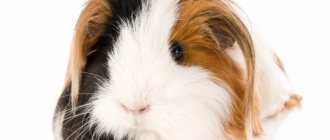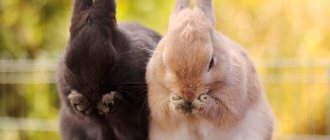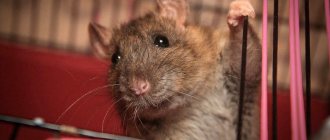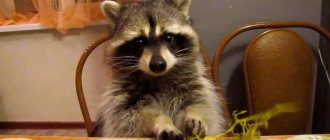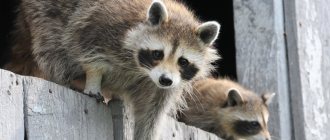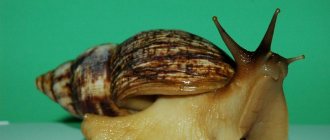Raccoon: description, structure, characteristics. What does a raccoon look like?
The name "raccoon" comes to us from the Indian word "Arakun", which translates as "scratching with one's hands."
Raccoons are carnivorous mammals belonging to the raccoon family, which includes four species of these animals (we will describe each species in more detail below). Also close relatives of raccoons are raccoon dogs (they are often confused with raccoons), nosuhi, kakimitsli and kinkajou. And the raccoon’s distant relatives even include dogs and pandas.
The most common among raccoons is the raccoon, which is also called the “gargle bear” or “washing bear.”
The body length of raccoons is usually 45-60 cm; the average weight of a raccoon, depending on the species, can vary from 2-5 to 8-15 kg. Moreover, males are often larger than females. The body structure of raccoons is a bit like
a fox or a dog. But the paws of a raccoon are an important distinguishing feature of these animals; they have very elongated pads, somewhat reminiscent of human palms. Thanks to the similar structure of their paws, all raccoons have excellent grasping abilities.
Raccoons climb trees with ease and can manipulate various small objects.
A raccoon's tail is long and usually bushy. A raccoon's fur depends on its species; for example, the raccoon's fur is short, while the raccoon's, Cosemelle and Guadalupe raccoons' fur is, on the contrary, longer and fluffier. As for color, all raccoons are grayish-brown in color, and their tail is painted with transverse black and white stripes.
The raccoon's head is very wide, has a short and sharp muzzle, and small and rounded ears.
Interesting fact: all raccoons not only climb trees with ease, but also swim well, and can swim even in cold water, which is facilitated by the special composition of their fur, consisting of 90% thick undercoat, as if specially adapted by nature to protect against cold water.
Description of the striped raccoon
Many people are interested in why the striped raccoon is called that. In fact, everything is very simple. This animal really rinses everything in water. From the outside it looks very funny. It seems that the animal simply erases according to the same principle as people. Raccoons usually drop pieces of food into the water and tug at them with their paws. But this is not an attempt to make tidbits cleaner. It's just that omnivorous raccoons often catch their prey in thick mud and algae. Handling their paws helps them quickly and easily remove food. But there is another name for the beast under discussion - the American raccoon.
- Outwardly, we can say that the animal resembles a fox or a dog. He usually evokes a wave of affection among people with his charming appearance.
- Such animals have short limbs, but with well-developed fingers. We can say that their paws are similar in structure to the hands of a child. Such limbs greatly facilitate the life of an animal in the wild.
- Raccoons have thick fur of varying lengths. The color is usually a mixture of brown and gray. The tail is very fluffy with dark rings. There may be up to a dozen of the latter.
Where do raccoons live?
Raccoons are native to North and South America and can be found in forests from Canada to Argentina. With the discovery of America by Europeans, raccoons came to Eurasia and one of their species, the striped raccoon, was able to take root quite well in our latitudes. In particular, populations of the striped raccoon have been created in many European countries and also in the Caucasus.
As for our country, Ukraine, in the hometown of the author of the article - Lviv, there is a whole raccoon farm - “
Raccoon House”, that is, you can come to visit the raccoons, play with them; such an event will definitely be unforgettable for children. To learn more about the “Raccoon House” in Lviv, follow the link.
Raccoon's house.
Features and habitat of the striped raccoon
The striped raccoon has a stocky and dense build. The total length of his body usually does not exceed sixty centimeters, and his height is thirty-five centimeters.
The weight of such raccoons varies from five to ten kilograms, although some individuals can significantly exceed this figure. Looking at the photo of the striped raccoon , you can see that the animal’s fur is thick and fluffy, and the undercoat is dense and matted.
The color of most individuals has gray-yellow shades, the back and sides are usually darker. The tail of raccoons has several light and dark stripes that alternate with each other, forming a beautiful, unique pattern.
The striped raccoon has a peculiar “mask”, which is its distinctive feature and sets it apart from other animals. It usually looks like two relatively symmetrical spots directly around the animal’s eyes.
The ears have a pointed shape. The paws of the striped raccoon are extremely mobile. On them the animal is able to both move and skillfully climb trees. The striped raccoon is native to both North and Central America, from which it was introduced to Europe and some Asian countries.
To date, this species has managed to acclimatize in countries such as Azerbaijan, Belarus, Germany, France and the Netherlands. On the territory of Russia you can also find raccoons, especially within the Far East.
Representatives of this species of raccoons prefer to settle directly among deciduous or mixed forests, mainly on plains or lowlands.
There must be some kind of body of water nearby: a stream, a swamp, a lake or a river. Striped raccoons living in southern areas can make their homes right on the coast.
The animal is not afraid of humans, and can settle in close proximity to cities and towns. They are often found in city squares, on the outskirts of parks and plantings, as well as among botanical gardens.
In North America, farmers are forced to wage real wars with raccoons, since they often raid chicken coops and plantings of fruit and vegetable crops.
Character and lifestyle of a raccoon
Raccoons have a friendly character, they are peaceful, active and inquisitive. However, despite their peacefulness, they are not cowardly, therefore, in case of danger, they are able to bravely defend themselves, bite and scratch. They can also rumble threateningly, trying to scare a potential enemy. In particularly dangerous situations, raccoons may flee or resort to a cunning trick - pretending to be dead.
Despite their friendliness and sociability, in natural conditions raccoons prefer to lead a solitary lifestyle, coming together only for mating and during hibernation. And yes, raccoons, like
Bears go into hibernation in winter, and the biological mechanisms of hibernation in raccoons are similar to those of bears; hibernation itself in raccoons lasts depending on the duration of the cold period. Canadian raccoons sleep the longest, in which hibernation can last up to 5 months, but raccoons living in the warm tropics of Central America do not hibernate at all, due to the lack of winter in their habitats.
Sleeping raccoon.
Raccoons are crepuscular animals, which means they are most active in the evening and at night, preferring to sleep in their cozy den during the day. But when evening comes, they go out in search of food. Although, if necessary, these animals can change their established daily routine.
Reproduction and lifespan
The breeding season for raccoons begins in the northern regions with the beginning of spring, and in the southern regions it has no boundaries. Males are polygamous and search for females by smell. After mating, they go in search of their next partner.
Males live alone and do not take part in raising offspring. Female raccoons are associated with only one chosen one. The factor of animal relationships is important to consider in captivity.
The female bears the offspring for 63 days. For the future preservation of the brood, raccoons look for spare holes in advance so that in case of danger they can move with the babies. There may be more than a dozen such shelters. A separate hollow is prepared for the birth of babies. Before the birth of the offspring, the female becomes very aggressive.
After the birth of the cubs, the female has to look for food for herself and her children.
Newborn raccoons do not see, do not hear, and they have no teeth. The baby weighs approximately 75 grams. A litter contains from one to six cubs, covered with short, light brown hair. Distinctive rings on the tail and a stripe on the head appear after 10 days of life. The eyes open after 2-3 weeks.
The female feeds the babies with milk for up to 3 months. Feeding occurs on average 20 times per day. Raccoons scream and whistle shrilly. As they grow older, the sounds made become quieter, and gradually the raccoons switch to adult food.
The female takes care of the offspring for up to 5 months, then the babies begin to live independently. In winter, some individuals remain near their mother. The cold period is a severe test for young animals. The surviving raccoons can be considered hardened for natural living conditions.
Young females become sexually mature after a year, males - by two years of age. In the natural environment, the life of cute animals lasts from 2 to 5 years. How long a striped raccoon lives in captivity depends on the conditions of detention and proper feeding. Life expectancy is 14 - 20 years.
Enemies of raccoons in nature
In turn, raccoons themselves can become prey for other larger predators: bears,
wolves, lynxes, coyotes, wolverines and cougars. In an attempt to escape from their enemies, raccoons often resort to trickery - pretending to be dead, but when this trick does not work and it is not possible to escape, they desperately resist, fighting with all their might for their lives. However, unfortunately, this is not always possible.
Also, to a certain extent, humans are the enemy of raccoons; American Indians sometimes killed these animals for their fur. Later, white colonists also began to practice hunting raccoons. Fortunately, the active reproduction of these animals has not put their population at risk.
Types of raccoons, photos and names
As we wrote above, there are 4 types of raccoons in nature, and below we will describe them in more detail:
Raccoon gargle
This raccoon got its unusual name due to its habit of rinsing caught prey in water. Thus, the clean raccoon cleans it of sand. It is also the most common among raccoons, found throughout North and Central America, and more recently in Europe. Everything we wrote above concerns primarily raccoons.
Racoon crayfish (aguara)
A distinctive feature of this raccoon is a characteristic pattern around the eyes, somewhat reminiscent of a bandit mask. This raccoon has shorter fur and a more streamlined body. It got its name from its gastronomic love for crayfish. Lives in the jungles of Central and South America.
Cozumel raccoon
This species of raccoon is very rare, as it lives in a limited area, namely on the small island of Cozumel in the Caribbean Sea. It also differs from its other relatives in its brownish-grayish fur and the presence of a yellow tint on the tail.
Guadalupe raccoon
This species of raccoon is currently critically endangered and is listed as
Red Book. It lives in the humid areas of Guadeloupe, preferring to settle in marshy areas, as well as near reservoirs, rivers and lakes. Its appearance is similar to a striped raccoon.
Raccoon eater
In South and Central America, where the raccoon lives, jungle tracts and swampy areas are most often observed. The external similarity with an ordinary raccoon is that they have a “mask” on the face and a fluffy tail. The difference is that their dimensions are slightly smaller, their body has a more streamlined shape, and their hair is short. These are solitary nocturnal animals that breed in the second half of summer. Most often, a female gives birth to 3 cubs. This type is characterized by the following parameters:
- Weight: 2-12 kilograms;
- How long do raccoons live - 10-13 years;
- Height at withers: slightly more than 20 cm;
- Body length: 40-60 centimeters (the length of the tail is additionally measured, which is 20-40 cm).
Crustaceans does not mean that the animal’s diet consists exclusively of crustaceans. They are omnivores. The presence of crabs and crayfish in the diet is determined by their presence in the raccoon habitat.
Author: Mikhail Reshetov
Author: Dmitry Ryabov
Author: Mikhail Reshetov
Reproduction of raccoons
Raccoons breed strictly once a year, during their mating season, which occurs either at the end of winter or at the beginning of summer (depending on the raccoon’s habitat, the further south it lives, the faster its mating season begins, for raccoons living in our temperate latitudes, the mating season is in early summer).
These animals have no special mating rituals, everything is extremely simple - the male finds the female by smell and mates with her. The pregnancy of a female raccoon lasts 2 months; birth occurs in some secluded place, usually a hollow tree or an abandoned hole of another animal.
From 3 to 8 small raccoons are born at a time. Baby raccoons, like kittens, are born blind and helpless, and at first they are under the full care of their mother, who feeds them with her breast milk. But after a month of their life, they begin to grow rapidly, by 4-5 months they are already able to obtain food on their own, and by the first year, raccoons reach sexual maturity and become adults.
How long do raccoons live in the wild?
In their natural habitat, raccoons prefer to live in trees and choose areas where there is nearby access to water. These animals skillfully move through trees, and when in danger, they hide in hollows in which they live and sleep.
Raccoons are considered extremely tenacious animals; they have excellent immunity to various diseases, but at the same time they are often carriers of them. Raccoons are considered predators, but at the same time they are absolutely omnivorous. So why is their average lifespan in the wild only 6 years?
Two main factors can explain this paradox:
- Human intervention - raccoons are able to quickly adapt to any conditions and very often settle next to humans. As the population of these animals grows, there are not enough natural food sources for them, so they begin to raid human homes, destroying crops, hunting small domestic animals at night and simply playing pranks. This behavior causes retaliatory measures, which is why raccoons are hunted and they rarely manage to live longer than 6 years. In addition, in some countries raccoon fur is highly valued.
- Natural enemies - in their natural habitat, raccoons also have enemies. Depending on their habitat, they include lynxes, wolves, coyotes, alligators, etc. Given the excessive curiosity and carelessness of raccoons, they can easily get caught in the teeth of a more ferocious predator, which is why their lives are interrupted prematurely.
Keeping raccoons at home
Raccoons make excellent pets due to their friendly nature. Just don’t get a raccoon if you live in a cramped apartment, since these animals need space, and they won’t be free-range like cats or dogs either.
It is very advisable to allocate a whole separate room for the raccoon; it will also be its enclosure, in which the animal will feel free. Since raccoons are very smart animals, you can have fun and play with them, but you should also be careful, because if the raccoon thinks that it is in danger, it can bite and scratch. Raccoons are especially aggressive during their mating season. Also, during the mating season, a male raccoon can mark his territory, which will be fraught with a very unpleasant odor. But in general, a raccoon can be trained to go to the litter box, almost like a cat or dog.
It is also worth considering that raccoons can be very mischievous, even hooligan animals; while living in a house, they can do all kinds of mischief, for example, break all the dishes in the kitchen, throw over an expensive TV, and so on. To avoid this, they should not be released from their enclosure room (at least without supervision), having first removed all valuable items from there.
And raccoons are crepuscular animals, which means that if you have such a pet in the house, you will need to adapt to its natural rhythm; the raccoon will most likely sleep during the day, but get rowdy in the evening and at night. You will also need to feed him in the evening and at night, in general, if you are a “night owl” according to your biorhythm, then with a raccoon it will be easier for you than for people who are “larks”.
Is it worth keeping a raccoon in an apartment or private house?
To keep a raccoon at home, you should have some patience, because the animals are highly curious, easily climb to high places, and love to open cabinets and boxes and turn over flowerpots. Because of this behavioral feature, all cabinets and doors that can be opened should be secured with tape. It is recommended to remove sharp and dangerous objects, household chemicals, and medications. It is necessary to close the raccoon because it can chew through wires or open water taps or gas valves. He also loves water, washing everything he can - from his owner’s things to cats. The main negative character traits of the raccoon include:
- moodiness,
- jealousy,
- vindictiveness,
- touchiness,
- excessive curiosity.
Negative traits offset the positive ones, because raccoons are loyal animals, they become true friends, and are affectionate towards children. Another plus is cleanliness! A raccoon can spend up to 3-4 hours a day in water, so there will be no unpleasant odors, which distinguishes it from rodents and even dogs. However, cleanliness sometimes goes to the extreme: the animal can spread the contents of a trash can in the kitchen, wash a rug, or mix perfume with cosmetics.
What to feed a raccoon
What to feed your pet raccoon? A partially omnivorous raccoon can be fed with the same things it has in its natural environment: these are various berries, fruits, and nuts. In addition, raccoons can be fed with specialized food for cats and dogs, but only premium food. You can give meat and fish, both raw and boiled, the main thing is not too fatty. Chicken, beef, turkey, veal and rabbit are excellent meats for raccoons. Raccoons eat excellent fruits: apples, pears, grapes, bananas, peaches, plums. Vegetables that will be useful to raccoons include: carrots, fresh peas, asparagus, and zucchini.
